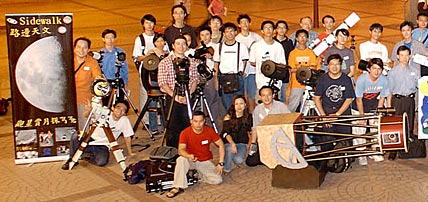
Hong Kong amateur astronomers were all smiles after hosting the first Hong Kong Sidewalk Astronomy Event at a busy tourist shopping center overlooking Victoria Harbor.
Photo by Alex Leung.
Visitors often describe Hong Kong's Victoria Harbor, with its colorful neon signs ablaze at night, as one of the most spectacular sights in the world. Its sky, however, is always awash with bright glow, making even 2nd-magnitude stars barely visible to the naked eye. Nevertheless, more than 100 amateur astronomers gathered in an open area next to the harbor on October 3rd to host the first Hong Kong Sidewalk Astronomy Event.
Participants offered telescopic views of the first-quarter Moon and the small orange disk of Mars to more than 1,500 passers-by, reports Eric Wai-kin Ng of the Hong Kong Astronomical Society (HKAS). The event was organized by the HKAS and the Hong Kong Space Museum. "Although the observing site was located at Tsimshatsui, a busy tourist district that is severely light polluted," says Ng, "it didn't diminish the enthusiasm of the participants."
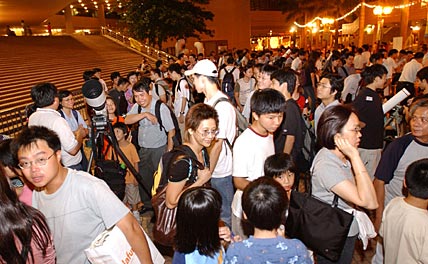
Hong Kong' sidewalk star party drew a crowd of more than 1,500 people. Following this success, several local astronomy groups are organizing another such event for December.
Photo by Alex Leung.
A total of 48 telescopes and binoculars were on hand for use by the public. "It's the largest display of astronomical equipment in Hong Kong that I could recall in the past 30 years," says HKAS president Kam-cheung Leung.
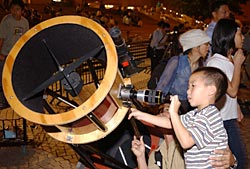
Hong Kong amateurs brought four dozen telescopes and binoculars for the event, including the homemade 16-inch f/4.5 Dobsonian reflector here. Clear skies afforded crowds of people their first telescopic views of the Moon and Mars.
Photo by Alex Leung.
Many first-time observers expressed amazement and disbelief at what they saw through the eyepiece. Exclamations such as "Don't cheat me!", "Are you projecting a picture in front of the telescope?" and "I don't believe those craters are real!" were heard throughout the night.
Imaging with webcams has become popular among local amateurs, so some experienced webcam imagers demonstrated their skills by shooting Mars and lunar craters on the spot and displaying the views on their laptop computers.
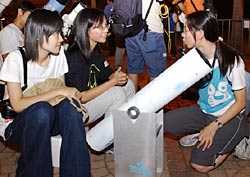
Flora Leung describes building her homemade 5-inch f/7 Dob.
Photo by Alex Leung.
A few amateur telescope makers brought their homemade gear. The largest was a 16-inch f/4.5 Dobsonian (above) which, understandably, drew a long line of eager observers. There was also a 5-inch f/7 Dobsonian made by Flora Leung (right), a high-school student who was very proud and excited when people told her how much they admired her handiwork. "It proves that my first telescope project is a success!" exclaimed Leung. She spent about 100 hours to complete the scope.
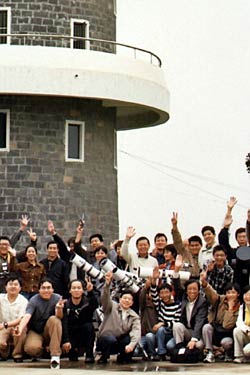
Attendees at the first Bootes Star Party gathered at the Xuyi Observing Station of Zijinshan Astronomical Observatory in Nanjing.
Courtesy Renjiang Xie.
Meanwhile, in mainland China, the first international Bootes Star Party took place from October 1st through 5th. About 100 professional and amateur astronomers from mainland China, Hong Kong, Taiwan, Malaysia, and Japan converged on Nanjing, about 900 kilometers southeast of Beijing, for the nearly week-long event.
Bootes is the name of the largest Chinese online astronomy discussion group, which has nearly 9,000 members worldwide. The gathering was hosted by the Jiangsu Province and Shanghai astronomical societies. "Although our attendance wasn't very large compared with those of our Western counterparts, it's the very first amateur star party in our country," says Renjiang Xie of the Dalian Astronomy Popularization Association.
Nanjing is the site of China's first modern observatory, on Zijinshan Mountain. This facility has some historic astronomical instruments made during the Ming (A.D. 1368–1644) and Qing (1644–1911) dynasties. After touring Zijinshan Observatory and other historic
sites, the attendees proceeded to the Xuyi Observing Station for the main lectures. Lau Kai Nang of Hong Kong gave a talk on astrophotography with the Philips ToUCam Pro webcam, while Sin Zang Sua of Malaysia discussed amateur activities in his country. Renowned Japanese observer Matsuya Ken of Tokyo shared his experiences and techniques. Other lecturers included representatives from local clubs and observatories. "We learned a lot from each other," says Xie.
The participants also had a chance to test telescopes of all types exhibited by several Chinese companies. The event ended with a visit to the famous Ming imperial tomb. Says Xie, "It was an unforgettable star party, and we all look forward to the next one!"
 0
0
Comments
You must be logged in to post a comment.